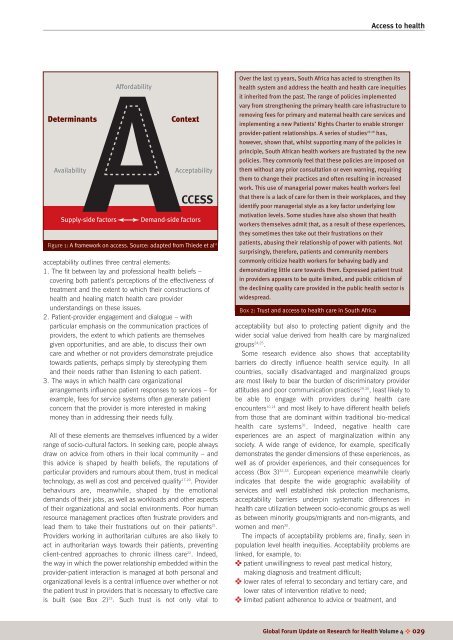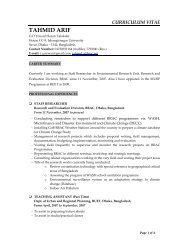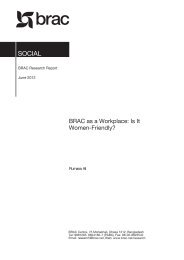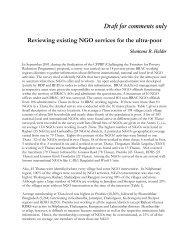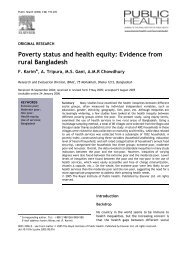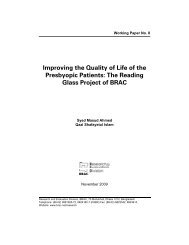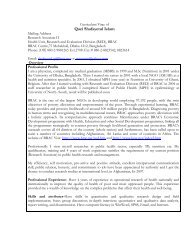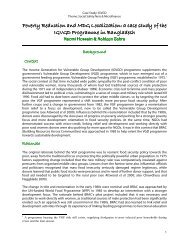Combining health and social protection measures to reach the ultra ...
Combining health and social protection measures to reach the ultra ...
Combining health and social protection measures to reach the ultra ...
Create successful ePaper yourself
Turn your PDF publications into a flip-book with our unique Google optimized e-Paper software.
Access <strong>to</strong> <strong>health</strong><br />
Determinants<br />
Availability<br />
Supply-side fac<strong>to</strong>rs<br />
Affordability<br />
Context<br />
Acceptability<br />
CCESS<br />
Dem<strong>and</strong>-side fac<strong>to</strong>rs<br />
Figure 1: A framework on access. Source: adapted from Thiede et al 12<br />
acceptability outlines three central elements:<br />
1. The fit between lay <strong>and</strong> professional <strong>health</strong> beliefs –<br />
covering both patient’s perceptions of <strong>the</strong> effectiveness of<br />
treatment <strong>and</strong> <strong>the</strong> extent <strong>to</strong> which <strong>the</strong>ir constructions of<br />
<strong>health</strong> <strong>and</strong> healing match <strong>health</strong> care provider<br />
underst<strong>and</strong>ings on <strong>the</strong>se issues.<br />
2. Patient-provider engagement <strong>and</strong> dialogue – with<br />
particular emphasis on <strong>the</strong> communication practices of<br />
providers, <strong>the</strong> extent <strong>to</strong> which patients are <strong>the</strong>mselves<br />
given opportunities, <strong>and</strong> are able, <strong>to</strong> discuss <strong>the</strong>ir own<br />
care <strong>and</strong> whe<strong>the</strong>r or not providers demonstrate prejudice<br />
<strong>to</strong>wards patients, perhaps simply by stereotyping <strong>the</strong>m<br />
<strong>and</strong> <strong>the</strong>ir needs ra<strong>the</strong>r than listening <strong>to</strong> each patient.<br />
3. The ways in which <strong>health</strong> care organizational<br />
arrangements influence patient responses <strong>to</strong> services – for<br />
example, fees for service systems often generate patient<br />
concern that <strong>the</strong> provider is more interested in making<br />
money than in addressing <strong>the</strong>ir needs fully.<br />
All of <strong>the</strong>se elements are <strong>the</strong>mselves influenced by a wider<br />
range of socio-cultural fac<strong>to</strong>rs. In seeking care, people always<br />
draw on advice from o<strong>the</strong>rs in <strong>the</strong>ir local community – <strong>and</strong><br />
this advice is shaped by <strong>health</strong> beliefs, <strong>the</strong> reputations of<br />
particular providers <strong>and</strong> rumours about <strong>the</strong>m, trust in medical<br />
technology, as well as cost <strong>and</strong> perceived quality 17-20 . Provider<br />
behaviours are, meanwhile, shaped by <strong>the</strong> emotional<br />
dem<strong>and</strong>s of <strong>the</strong>ir jobs, as well as workloads <strong>and</strong> o<strong>the</strong>r aspects<br />
of <strong>the</strong>ir organizational <strong>and</strong> <strong>social</strong> environments. Poor human<br />
resource management practices often frustrate providers <strong>and</strong><br />
lead <strong>the</strong>m <strong>to</strong> take <strong>the</strong>ir frustrations out on <strong>the</strong>ir patients 21 .<br />
Providers working in authoritarian cultures are also likely <strong>to</strong><br />
act in authoritarian ways <strong>to</strong>wards <strong>the</strong>ir patients, preventing<br />
client-centred approaches <strong>to</strong> chronic illness care 22 . Indeed,<br />
<strong>the</strong> way in which <strong>the</strong> power relationship embedded within <strong>the</strong><br />
provider-patient interaction is managed at both personal <strong>and</strong><br />
organizational levels is a central influence over whe<strong>the</strong>r or not<br />
<strong>the</strong> patient trust in providers that is necessary <strong>to</strong> effective care<br />
is built (see Box 2) 23 . Such trust is not only vital <strong>to</strong><br />
Over <strong>the</strong> last 13 years, South Africa has acted <strong>to</strong> streng<strong>the</strong>n its<br />
<strong>health</strong> system <strong>and</strong> address <strong>the</strong> <strong>health</strong> <strong>and</strong> <strong>health</strong> care inequities<br />
it inherited from <strong>the</strong> past. The range of policies implemented<br />
vary from streng<strong>the</strong>ning <strong>the</strong> primary <strong>health</strong> care infrastructure <strong>to</strong><br />
removing fees for primary <strong>and</strong> maternal <strong>health</strong> care services <strong>and</strong><br />
implementing a new Patients’ Rights Charter <strong>to</strong> enable stronger<br />
provider-patient relationships. A series of studies 26-28 has,<br />
however, shown that, whilst supporting many of <strong>the</strong> policies in<br />
principle, South African <strong>health</strong> workers are frustrated by <strong>the</strong> new<br />
policies. They commonly feel that <strong>the</strong>se policies are imposed on<br />
<strong>the</strong>m without any prior consultation or even warning, requiring<br />
<strong>the</strong>m <strong>to</strong> change <strong>the</strong>ir practices <strong>and</strong> often resulting in increased<br />
work. This use of managerial power makes <strong>health</strong> workers feel<br />
that <strong>the</strong>re is a lack of care for <strong>the</strong>m in <strong>the</strong>ir workplaces, <strong>and</strong> <strong>the</strong>y<br />
identify poor managerial style as a key fac<strong>to</strong>r underlying low<br />
motivation levels. Some studies have also shown that <strong>health</strong><br />
workers <strong>the</strong>mselves admit that, as a result of <strong>the</strong>se experiences,<br />
<strong>the</strong>y sometimes <strong>the</strong>n take out <strong>the</strong>ir frustrations on <strong>the</strong>ir<br />
patients, abusing <strong>the</strong>ir relationship of power with patients. Not<br />
surprisingly, <strong>the</strong>refore, patients <strong>and</strong> community members<br />
commonly criticize <strong>health</strong> workers for behaving badly <strong>and</strong><br />
demonstrating little care <strong>to</strong>wards <strong>the</strong>m. Expressed patient trust<br />
in providers appears <strong>to</strong> be quite limited, <strong>and</strong> public criticism of<br />
<strong>the</strong> declining quality care provided in <strong>the</strong> public <strong>health</strong> sec<strong>to</strong>r is<br />
widespread.<br />
Box 2: Trust <strong>and</strong> access <strong>to</strong> <strong>health</strong> care in South Africa<br />
acceptability but also <strong>to</strong> protecting patient dignity <strong>and</strong> <strong>the</strong><br />
wider <strong>social</strong> value derived from <strong>health</strong> care by marginalized<br />
groups 24,25 .<br />
Some research evidence also shows that acceptability<br />
barriers do directly influence <strong>health</strong> service equity. In all<br />
countries, <strong>social</strong>ly disadvantaged <strong>and</strong> marginalized groups<br />
are most likely <strong>to</strong> bear <strong>the</strong> burden of discrimina<strong>to</strong>ry provider<br />
attitudes <strong>and</strong> poor communication practices 29,30 , least likely <strong>to</strong><br />
be able <strong>to</strong> engage with providers during <strong>health</strong> care<br />
encounters 10,14 <strong>and</strong> most likely <strong>to</strong> have different <strong>health</strong> beliefs<br />
from those that are dominant within traditional bio-medical<br />
<strong>health</strong> care systems 31 . Indeed, negative <strong>health</strong> care<br />
experiences are an aspect of marginalization within any<br />
society. A wide range of evidence, for example, specifically<br />
demonstrates <strong>the</strong> gender dimensions of <strong>the</strong>se experiences, as<br />
well as of provider experiences, <strong>and</strong> <strong>the</strong>ir consequences for<br />
access (Box 3) 32,33 . European experience meanwhile clearly<br />
indicates that despite <strong>the</strong> wide geographic availability of<br />
services <strong>and</strong> well established risk <strong>protection</strong> mechanisms,<br />
acceptability barriers underpin systematic differences in<br />
<strong>health</strong> care utilization between socio-economic groups as well<br />
as between minority groups/migrants <strong>and</strong> non-migrants, <strong>and</strong><br />
women <strong>and</strong> men 30 .<br />
The impacts of acceptability problems are, finally, seen in<br />
population level <strong>health</strong> inequities. Acceptability problems are<br />
linked, for example, <strong>to</strong>:<br />
✜ patient unwillingness <strong>to</strong> reveal past medical his<strong>to</strong>ry,<br />
making diagnosis <strong>and</strong> treatment difficult;<br />
✜ lower rates of referral <strong>to</strong> secondary <strong>and</strong> tertiary care, <strong>and</strong><br />
lower rates of intervention relative <strong>to</strong> need;<br />
✜ limited patient adherence <strong>to</strong> advice or treatment, <strong>and</strong><br />
Global Forum Update on Research for Health Volume 4 ✜ 029


